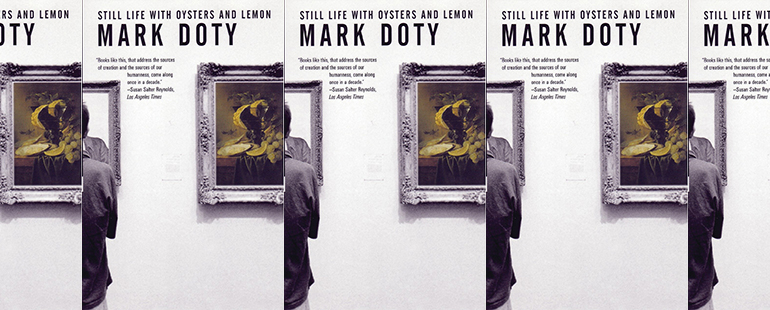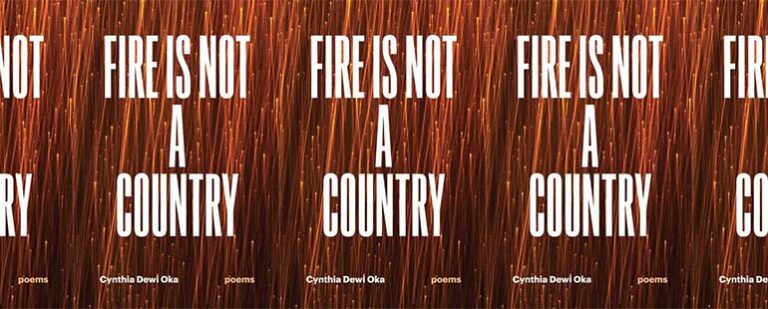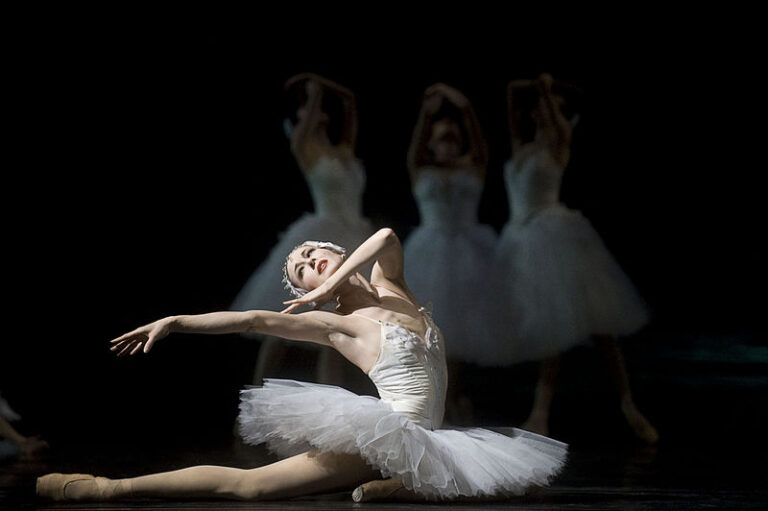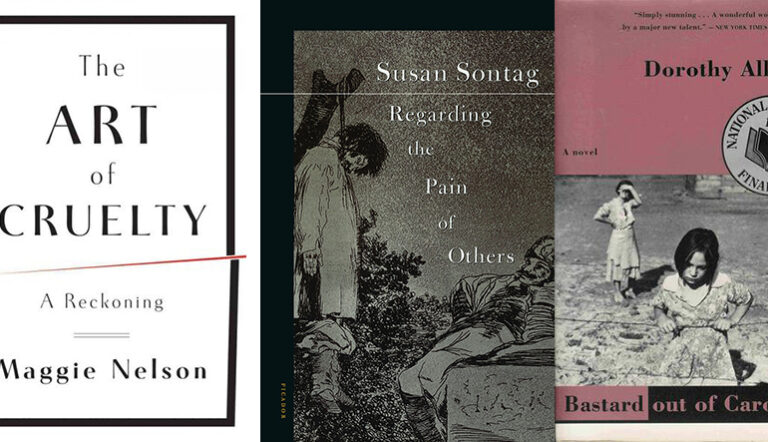Still Life with Oysters and Lemon’s Meditation on Life, Death, and Memory

Still Life with Oysters and Lemon: On Objects and Intimacy (2001) is a meditation by the poet Mark Doty on a painting Jan Davidsz de Heem made in Antwerp 350 years ago. The painting depicts shucked oysters, a curled lemon peel, some grapes, and a glass of red wine. For Doty the surface of this artwork is brimming, and he has fallen in love with it. The oysters are shimmery, the grapes are dewy, the wine is amber. The background is dark. Yet it is a glimmering surface, which asserts the world as “a dialogue between degrees of transparency…degrees of reflectivity.” An inquiry into the surface leads Doty to submarine depths. He uses the painting to revisit the “instructive, resonant thing[s]” of his life that circle moments of love, intimacy, and grief. Peppermints his grandmother gave him as a child; the wig his mother-in-law wore in the final days of her illness; the chipped blue and white platter Doty’s partner Wally hung above the mantle, which remained there long after Wally’s death. Disparate things owned by people he loved and grieved, each held together by Doty’s text like the light in De Heem’s still life holds the peel, the glass, the oysters, and the grapes.
An intoxication—this is how Doty (a Ploughshares guest editor and frequent contributor) describes the emergence of still life. In the sixteenth century the Netherlands became intoxicated with newfound wealth. The first still lives are odes to this abundance, an overflow of hams, cabbages, and hares, with the background a little biblical scene to reassure that this new wealth is blessed. But within a few years this overindulgence shifts into something else, something Doty calls more rigorous. The composition cuts down to just a few objects; the background blurs into darkness. The paintings now celebrate something quieter than overabundance, something closer to everyday life. And Doty’s own book follows this evolution, opening with a scene of him drunk on his love for De Heems’ still life, exiting the halls of the Met into an icy gray Manhattan day. Doty holds within him the warmth the painting ignited in him, which expands out and envelopes everything he sees—tourist groups, flocks of pigeons, exhaust fumes—until he feels we are all moving in the light of this centuries-old painting no bigger than a notebook. This profusion of light, of air, and of Doty’s love for de Heems’s still life will deepen over the book’s seventy pages into something else.
If still life is a background of lustrous dark space against which shines life, Doty uses this composition to show how memory illuminates certain people and objects while allowing others to recede. When his grandmother produces peppermints during a visit to black bears in Tennessee, he thinks of “the gesture of her hand reaching down into invisibility and coming up with two or three of the little pinwheels,” while the bears themselves lumber out of “the dark spaces between the pines.” Later in Doty’s life, when he is auction hopping with Wally in Vermont, he describes the objects as excavated, “carried out, up from cellars, out of attics and back rooms,” and to this gothic-leaning scenery he adds the dealers, who “lurched across the grass toward us, in the half-dark, like the ghouls of in Night of the Living Dead.” Maybe the peppermints and the bears and the auction dealers all truly did emerge from the dark, but I suspect Doty is illustrating here the mechanisms of his memory, which he compares at one point to a Magic 8 Ball. Just as the ball’s messages float into view from a dark liquid, Doty believes “there is a space in me that is like the dark inside that hollow sphere, and things float up into view, images that are vessels of meaning, the flotsam and detail of any particular moment. Vanished things.” From the Magic 8 Ball of Doty’s mind emerge the bears, the peppermints, and the dealers.
Doty is careful to include examples of forgotten people and things. This oblivion into which some objects sink is the dark background against which the others shine. Wally had nicknames for other regulars at the auctions, but these have sunk into the dark liquid of Doty’s memory. And then there is the smell of his grandmother’s house, a mix of Pinesol, polish, rosewater, and mildew. He wonders if that smell still exists somewhere in the houses of older women, as though it were sitting in an armchair, waiting for him to come home. As for the grand ramshackle house of his mother-in-law—it was sold, and potentially demolished. “Nothing that was in it remains now,” Doty writes, “save perhaps some things gone to my wife’s brother or his children, who knows.” Second-hand nostalgia even seems to haunt Doty when buying the platter for the mantel, as he thinks of the blue and white ceramics that decorate his mother’s childhood home. The loss of objects that populated our life is not the same as the loss of a loved one, but they have a peculiar kind of vibrancy that Still Life with Oysters and Lemon examines with attention and care.
What remains after a person dies? Doty seems to ask again and again. Memories warp while grief folds itself into everyday life. Only objects truly remain the same, perhaps gaining a few chips along the way. One of the little disappearances Doty concerns himself with is the narratives they hold. He enjoys auctions set in peoples’ homes because he has a sense of the life the object decorated before. In contrast, the genre of still life depicts objects with feeling, but without narrative. Three hundred years ago a person cared for these objects, carefully selected them, and arranged them just so. Now there is oil on canvas, or maybe a few words printed across paper. Whatever personal story behind the objects has fallen away, yet for Doty the story still casts an intimate glow.
A still life is life with death in it. The objects depicted always suggest they are just past their prime. They are meant as memento mori, reminders of the ephemerality of life. Stems droop, petals curl, and the lemon is speckled with mold. The most surprising use of light in Still Life with Oysters and Lemon follows Wally’s death. Death is often described as a stilling or a darkening, but in the room where Wally spent his last days, “his death filled the space with a strange, vital light—a light inside the light.” Doty experienced an “odd, profound sense of life in that room, life lived out and through.” As though his death marked not the end of a life but a surplus of life. In the subsequent period of grief, Doty says the door to the other world was left a little ajar so that he could see beyond the daily, as though death was a light coming through an opening, momentarily illuminating the scene. And this strikes me as a good description of painted still life: a depiction of the daily, with a hint to what lies beyond.
Musing on the Netherlandish fad of still life, wondering why, over a century and a half, the country gave itself to an “oddly egoless outpouring,” a deep romance with the painted image, Doty recalls Zibniew Herbert’s comment that such paintings “increase the store of reality”—as though reality were a larder, and the paintings stocked it with meat and fish. Of course, I can’t resist applying this comment to Doty’s book. His imagery is handsome and evocative, each figure of speech interlinked through their preoccupation with light. It constantly builds upon what came before, increasing the store of reality. But this doesn’t make the effect dense or heavy. It’s as though Doty were de Heem himself, applying touches of paint here and there, layering the surface until a table and four objects appear, illusionistic yet real. Still Life with Oysters and Lemon isn’t only about the painting whose title it shares. It’s a still life in itself, pearlescent and bronzy. I can see it in my mind’s eye—a dark painting hangs on the wall, while before it some peppermints lay scattered on a wood table, next to a wig and a blue and white platter. Its surface brims.


